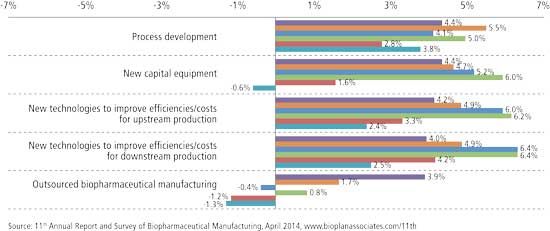Outsourcing No Longer Just for Cost-Cutting
With budgets growing, clients see CMOs' costs as less crucial.
Biopharmaceutical companies have traditionally considered outsourcing as a way to control costs and manage their internal resources to make the core activities left in-house more efficient. In recent years, surveys of biopharmaceutical manufacturers by BioPlan Associates have shown that cost cutting is, by far, not the primary reason companies outsource anymore. In fact, this factor ranks far below other measures. New data from the 11th Annual Report and Survey of Biopharmaceutical Manufacturing Capacity and Production (1) indicate that cost control is becoming less of a driver of outsourcing activity. This reduction is due in part to outsourcing becoming more highly interwoven with higher-end, technical activities for which the right partner is more important than an extra dollar saved. This trend also dovetails with evidence of a significant expansion in planned funding for outsourcing activities.
As part of the study, BioPlan evaluated how companies are addressing cost issues in biopharmaceutical manufacturing through their actions. As with the past three years, the most common action being taken by respondents was to implement programs to reduce operating costs. This action was done by 70.3% of the more than 200 global respondents to this year’s study. The numbers are consistent with last year’s study, though down slightly from prior years, when budgets may have been a little tighter.
Other common actions taken by companies to cut costs include reducing process development times and costs, implementing operational excellence programs such as Six Sigma, and implementing “lean manufacturing” programs, each by more than 4 in 10 respondents. Against that backdrop, the responses found specific to outsourcing were much less significant. In fact, of the 19 actions identified, the five specific to outsourcing were among the six least-taken. What’s more, after a couple of years of increases, the percentage of respondents this year having used outsourcing as a cost-cutting mechanism was for the most part either flat or down from last year’s study, for example:
- After doubling from 7% of respondents in 2011 to 14% last year (2), the share in this year’s respondents outsourcing manufacturing to domestic service providers specifically to cut costs fell to below 10%.
- After more than doubling from 5.7% of respondents in 2011 to 12.6% last year, the percentage of respondents in this year’s study who off-shored manufacturing to cut costs was essentially flat, at 13.1%.
Those trends weren’t unique to outsourcing of manufacturing. Fewer respondents reported having outsourced jobs in process development and R&D to cut costs, while the percentage that outsourced jobs in manufacturing remained flat after two years of increases. These results indicate that while outsourcing can, and does, play a role in cost containment, it is no longer a top priority when facilities are looking to cut costs.
Fewer clients evaluate CMOs on their cost
The data concerning cost-cutting changes specific to outsourcing is particularly interesting in light of separate results from BioPlan’s study where we evaluated the importance of various attributes that clients consider when they partner with CMOs. When companies were asked to rate the importance of 19 attributes when considering outsourcing to a CMO, only 22% this year said that cost was “very important.” Essentially, CMOs are less expected to demonstrate the cost-effectiveness of their services. We found this attribute in the bottom quartile of the list.
That is a significant departure from last year’s study in which this attribute was in the top third—cited by almost twice as many respondents (42%) as being very important. Additionally, it was one of only a few attributes that saw a decrease in perceived level of importance this year relative to last, and the 22% of respondents seeing it as such was the lowest share seen in BioPlan’s annual studies going back at least to 2006.
What could be the cause of this change? It’s possible that the biopharmaceutical community is increasingly looking at CMOs as partners that can provide highly-specialized equipment, expert technical knowledge and flexibility beyond what is available in-house. That’s especially the case when companies look to outsource higher-value activities, such as process development or quality-by-design services. From that context, selecting a CMO is less about going with the lowest bidder and more about finding the right fit from a technical and relationship standpoint.
Outsourcing budgets are trending up
Another reason why biomanufacturers may be paying less attention to outsourcing from a cost standpoint is that their budgets for outsourcing are expanding relatively quickly. The BioPlan study asked respondents to consider the current economic situation and forecast to what degree their funding would change over the next 12 months for 12 separate areas. In comparison to areas such as new capital equipment (where budget increases are not keeping pace) or process development, budgets for outsourcing of biopharmaceutical manufacturing are growing, year-on-year, far more quickly than other areas (see Figure 1).

Overall, the study reveals that more than one-third (37.3%) of respondents are projecting an increase in their funding of outsourced manufacturing to some degree. As a result, on average, it is estimated that budgets for outsourced manufacturing will increase by 3.9% this year. That’s a marked uptick from budget projections made over the prior 5 years, which ranged from a low of -1.3% to a high of 1.7%.
Other results from the study confirm this shift. Separately, respondents were asked to indicate how their spending on outsourcing will change over the following 12 months in manufacturing or R&D. Budget enthusiasm was even more pronounced: Almost half (49.9%) of respondents (vs 43.7% last year) said that their spending on outsourcing of R&D or manufacturing would increase to some extent over the next 12 months
Based on these data, BioPlan estimates that, on average, budgets for outsourcing at individual facilities will increase by 15.6% over the next 12 months, compared to estimated increases of 10.4% last year and 9.3% the year before.
Will the trends hold?
A common complaint made by CMOs in past editions of BioPlan’s industry study has been that clients want to contain costs by doing limited development runs, but still expect successful full-scale manufacturing. Biomanufacturers’ focus on cost-cutting has no doubt affected their interactions with CMOs, and relationships can easily be strained when clients are looking to cut corners.
Data indicate that these concerns might ease this year as clients take a more balanced approach to outsourcing that values benefits beyond simple cost containment. This is likely a reflection of financial situations, which have eased somewhat after the dire conditions seen a few years ago. It remains to be seen whether or not clients will retain this new approach to outsourcing when difficult times strike again.
References
1. BioPlan Associates, 11th Annual Report and Survey of Biopharmaceutical Manufacturing Capacity and Production (Rockville, Md., April 2014).
2. BioPlan Associates, 10th Annual Report and Survey of Biopharmaceutical Manufacturing Capacity and Production (Rockville, Md., April 2013).

About the Author
Eric Langer is president of BioPlan Associates, tel. 301.921.5979, elanger@bioplanassociates.com, and a periodic contributor to Outsourcing Outlook.

Drug Solutions Podcast: A Closer Look at mRNA in Oncology and Vaccines
April 30th 2024In this episode fo the Drug Solutions Podcast, etherna’s vice-president of Technology and Innovation, Stefaan De Koker, discusses the merits and challenges of using mRNA as the foundation for therapeutics in oncology as well as for vaccines.